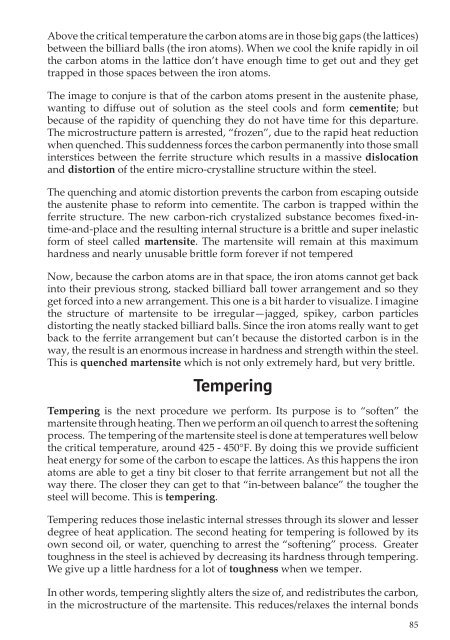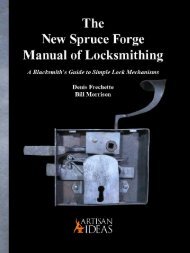FORGED: Making a Knife with Traditional Blacksmith Skills
This book will teach you to hand build a knife using the traditional method of blacksmiths of old — FORGING. Traditional forging of a knife blade is a process which uses the ancient techniques of moving hot steel with hammer and anvil alone into a knife-form that is ready for filing, heat treating and sharpening with no or very minimal electric grinding. This book also teaches traditional fit-and-finish skills using only hand tools. It explains an ancient riveted full-tang handle construction system that surpasses modern methods. In the author's words; "In my early blacksmithing years, I was lucky to get to know some old smiths who wrangled hot iron every day just to make a living. They unselfishly taught me traditional blacksmithing skills and knife forging methods. Every time I use those skills and methods, I honor their friendships, and by teaching you, the reader, we keep alive the memory of those old-time iron pounders." Hardcover, 132 pages, 150 photos and illustrations, $29.95.
This book will teach you to hand build a knife using the traditional method of blacksmiths of old — FORGING.
Traditional forging of a knife blade is a process which uses the ancient techniques of moving hot steel with hammer and anvil alone into a knife-form that is ready for filing, heat treating and sharpening with no or very minimal electric grinding.
This book also teaches traditional fit-and-finish skills using only hand tools. It explains an ancient riveted full-tang handle construction system that surpasses modern methods.
In the author's words; "In my early blacksmithing years, I was lucky to get to know some old smiths who wrangled hot iron every day just to make a living. They unselfishly taught me traditional blacksmithing skills and knife forging methods. Every time I use those skills and methods, I honor their friendships, and by teaching you, the reader, we keep alive the memory of those old-time iron pounders."
Hardcover, 132 pages, 150 photos and illustrations, $29.95.
Create successful ePaper yourself
Turn your PDF publications into a flip-book with our unique Google optimized e-Paper software.
Above the critical temperature the carbon atoms are in those big gaps (the lattices)<br />
between the billiard balls (the iron atoms). When we cool the knife rapidly in oil<br />
the carbon atoms in the lattice don’t have enough time to get out and they get<br />
trapped in those spaces between the iron atoms.<br />
The image to conjure is that of the carbon atoms present in the austenite phase,<br />
wanting to diffuse out of solution as the steel cools and form cementite; but<br />
because of the rapidity of quenching they do not have time for this departure.<br />
The microstructure pattern is arrested, “frozen”, due to the rapid heat reduction<br />
when quenched. This suddenness forces the carbon permanently into those small<br />
interstices between the ferrite structure which results in a massive dislocation<br />
and distortion of the entire micro-crystalline structure <strong>with</strong>in the steel.<br />
The quenching and atomic distortion prevents the carbon from escaping outside<br />
the austenite phase to reform into cementite. The carbon is trapped <strong>with</strong>in the<br />
ferrite structure. The new carbon-rich crystalized substance becomes fixed-intime-and-place<br />
and the resulting internal structure is a brittle and super inelastic<br />
form of steel called martensite. The martensite will remain at this maximum<br />
hardness and nearly unusable brittle form forever if not tempered<br />
Now, because the carbon atoms are in that space, the iron atoms cannot get back<br />
into their previous strong, stacked billiard ball tower arrangement and so they<br />
get forced into a new arrangement. This one is a bit harder to visualize. I imagine<br />
the structure of martensite to be irregular—jagged, spikey, carbon particles<br />
distorting the neatly stacked billiard balls. Since the iron atoms really want to get<br />
back to the ferrite arrangement but can’t because the distorted carbon is in the<br />
way, the result is an enormous increase in hardness and strength <strong>with</strong>in the steel.<br />
This is quenched martensite which is not only extremely hard, but very brittle.<br />
Tempering<br />
Tempering is the next procedure we perform. Its purpose is to “soften” the<br />
martensite through heating. Then we perform an oil quench to arrest the softening<br />
process. The tempering of the martensite steel is done at temperatures well below<br />
the critical temperature, around 425 - 450°F. By doing this we provide sufficient<br />
heat energy for some of the carbon to escape the lattices. As this happens the iron<br />
atoms are able to get a tiny bit closer to that ferrite arrangement but not all the<br />
way there. The closer they can get to that “in-between balance” the tougher the<br />
steel will become. This is tempering.<br />
Tempering reduces those inelastic internal stresses through its slower and lesser<br />
degree of heat application. The second heating for tempering is followed by its<br />
own second oil, or water, quenching to arrest the “softening” process. Greater<br />
toughness in the steel is achieved by decreasing its hardness through tempering.<br />
We give up a little hardness for a lot of toughness when we temper.<br />
In other words, tempering slightly alters the size of, and redistributes the carbon,<br />
in the microstructure of the martensite. This reduces/relaxes the internal bonds<br />
85










